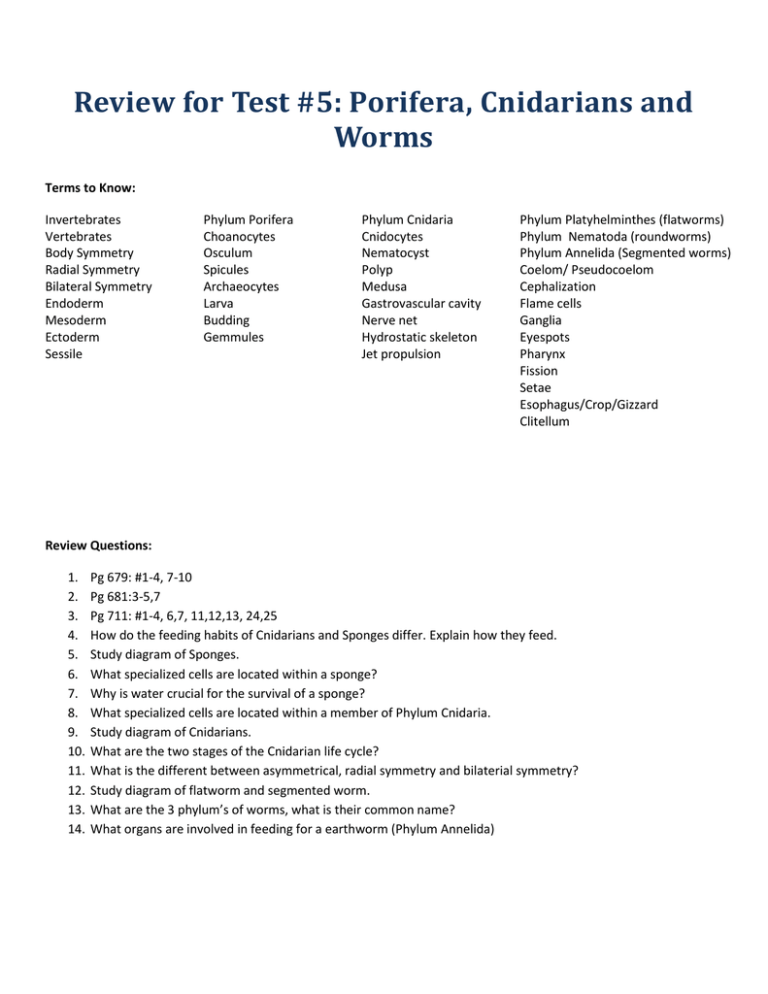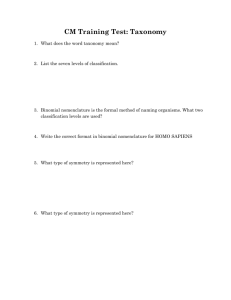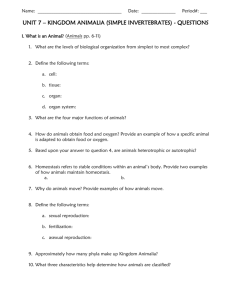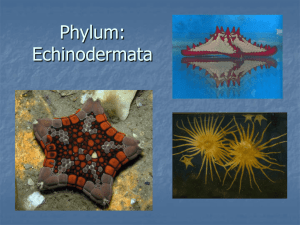review_for_test_5
advertisement

Review for Test #5: Porifera, Cnidarians and Worms Terms to Know: Invertebrates Vertebrates Body Symmetry Radial Symmetry Bilateral Symmetry Endoderm Mesoderm Ectoderm Sessile Phylum Porifera Choanocytes Osculum Spicules Archaeocytes Larva Budding Gemmules Phylum Cnidaria Cnidocytes Nematocyst Polyp Medusa Gastrovascular cavity Nerve net Hydrostatic skeleton Jet propulsion Phylum Platyhelminthes (flatworms) Phylum Nematoda (roundworms) Phylum Annelida (Segmented worms) Coelom/ Pseudocoelom Cephalization Flame cells Ganglia Eyespots Pharynx Fission Setae Esophagus/Crop/Gizzard Clitellum Review Questions: 1. 2. 3. 4. 5. 6. 7. 8. 9. 10. 11. 12. 13. 14. Pg 679: #1-4, 7-10 Pg 681:3-5,7 Pg 711: #1-4, 6,7, 11,12,13, 24,25 How do the feeding habits of Cnidarians and Sponges differ. Explain how they feed. Study diagram of Sponges. What specialized cells are located within a sponge? Why is water crucial for the survival of a sponge? What specialized cells are located within a member of Phylum Cnidaria. Study diagram of Cnidarians. What are the two stages of the Cnidarian life cycle? What is the different between asymmetrical, radial symmetry and bilaterial symmetry? Study diagram of flatworm and segmented worm. What are the 3 phylum’s of worms, what is their common name? What organs are involved in feeding for a earthworm (Phylum Annelida) Review for Test #5: Answer Key Pg 679: 1:C 2:C 3:A 4:B 7:C 8:B 9:A 10:B Pg 681: 3:E 4:C 5:A 7:D Pg 711: 1:D 2:B 3:B 4:C 6:B 7:C 11: A coelomate has a body cavity lined with mesoderm; an acoelomate does not. 12:Oxygen and nutrients are taken in through the skin and diffuse to internal cells, wastes are also removed through diffusion. 13:The pharynx takes food into the gastrovascular cavity, inside the gut, digestion and absorption occur. 24:A hermaphrodite is an animal that produces both sperm and eggs. Earthworm could be an example. 25:Aquatic annelids respire through gills. Land-dwelling annelids respire through their moist skin. 4: Cnidarian are carnivorous animals who utilize their tentacles to paralyze prey and pull in into their mouth/gastrovascular cavity. Sponges are filter feeders that trap microscopic particles through the use of their choanocytes. Digestion occurs with the help of the archeaocytes. 6:Choanocyte, Archaeocyte. 7: Water is required to undergo all of their 7 essential functions. Feeding-filter feeders trap microscopic food particles. Respiration, diffusion of oxygen from water, Reproduction: require water for sperm to move to eggs….etc 8: Cnidocytes, Nematocyst, Nerve net, Hydrostatic Skeleton, 10: Polyp and Medusa 11: Asymmetrical: no planes of symmetry can be found Radial symmetry: Many planes of symmetry can be found around the center of the organism. Bilateral symmetry: Only 1 plane of symmetry can be found. 13: Phylum Platyhelminthes: Flatworms Phylum Nematoda: Roundworms Phylum Annelida: Segmented worms 14: Pharynx, Esphogus, Crop, and Gizzard




